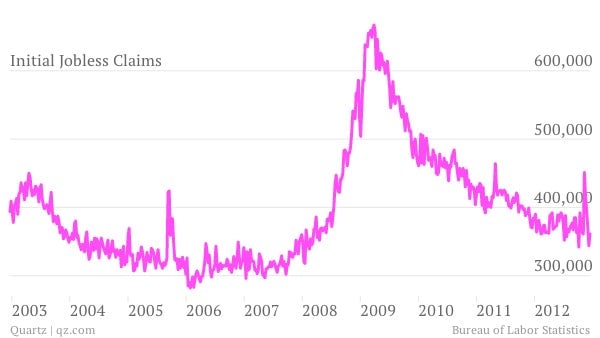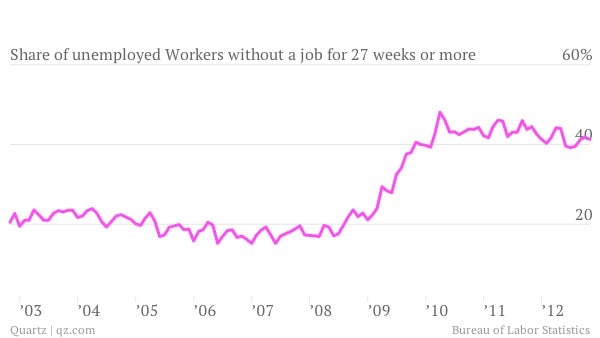The reason for stimulus in the fiscal cliff deal? 5 million Americans out of work for six months or more
Today, we found out that that initial jobless claims in the United States—how many people asked for unemployment insurance—popped up to 361,000, a bit higher than many economists expected. Still, as you can see from the above chart, the number of people being laid off has been decreasing fairly steadily since the economic crisis. The other news today was the revision of third-quarter growth to 3.1%—a respectable level of growth.

Today, we found out that that initial jobless claims in the United States—how many people asked for unemployment insurance—popped up to 361,000, a bit higher than many economists expected. Still, as you can see from the above chart, the number of people being laid off has been decreasing fairly steadily since the economic crisis. The other news today was the revision of third-quarter growth to 3.1%—a respectable level of growth.
So why does US President Barack Obama want to include stimulus, and particularly an extension of unemployment benefits, in a deal to avert America’s Jan. 1 automatic austerity package, a complication on top of disputes over tax revenues and social insurance cuts?

It’s because one component of the fiscal cliff is the expiration of unemployment benefits for 2.1 million Americans among the 40% of unemployed workers who haven’t found a job in six months. This is an unusually high level of long-term unemployment, affecting 5 million Americans. The US has never allowed unemployment benefits to expire while the unemployment rate is above 7.2%, and today it is 7.9%.
While extending benefits for the unemployed is a compassionate act, it’s also important to the economy at large: Taking away 2 million people’s incomes all at once would have broad ramifications—allowing them to expire would reduce growth by .4% of GDP, according to calculations by the Economic Policy Institute. But the cost of extending the benefits, $26 billion, is a relative drop in the bucket, considering how close both parties were to a deal earlier in the week.
Unemployment insurance isn’t the only high-multiplier piece of economic stimulus Obama wants to include in the fiscal cliff deal—he’d like to add $50 billion in much-needed infrastructure investment—but it’s probably the most important in the near term.